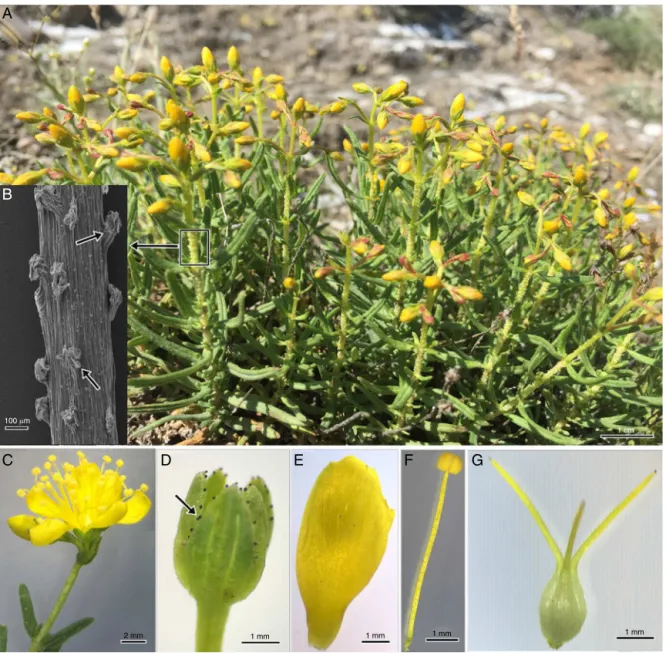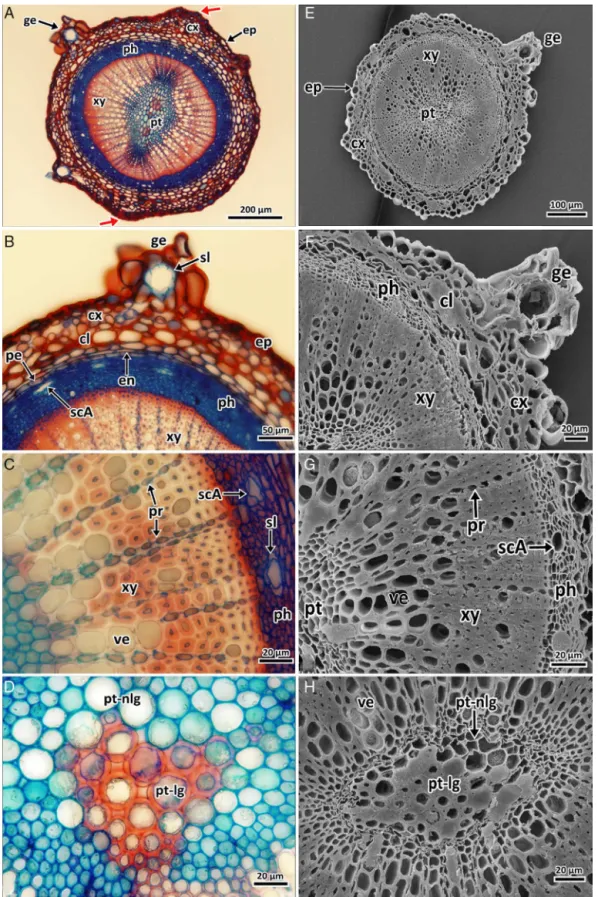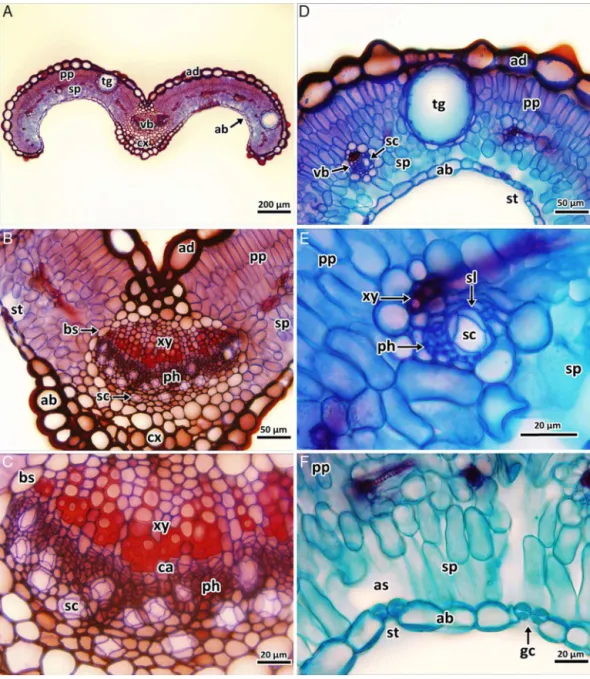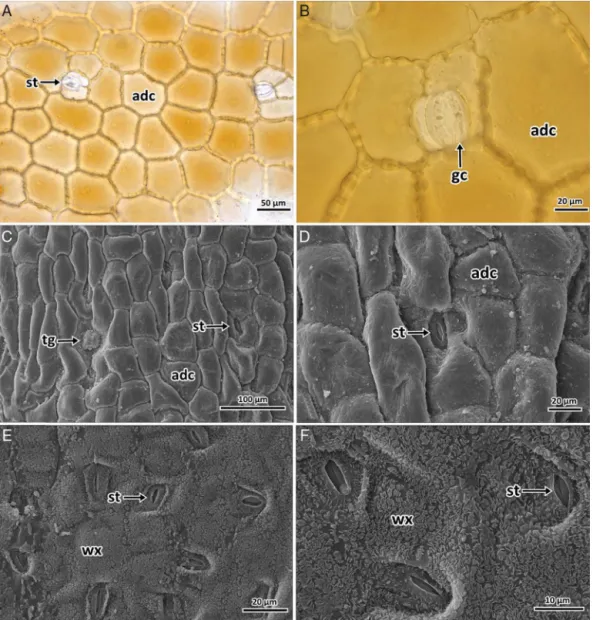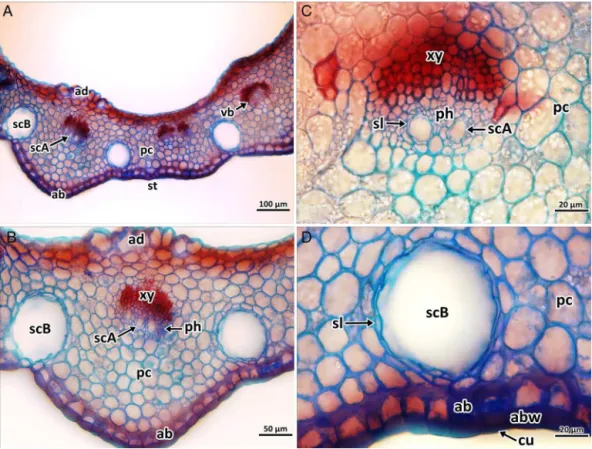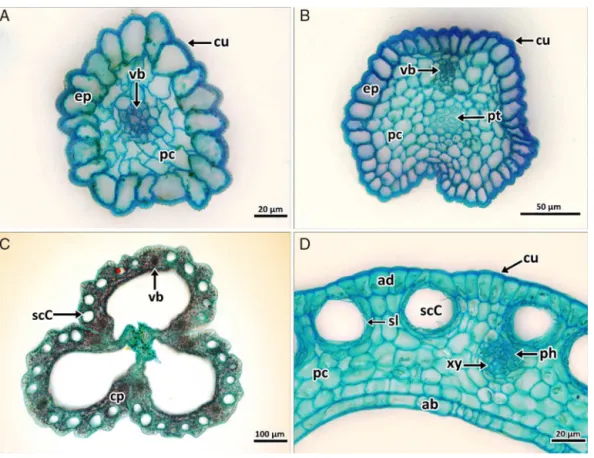w ww . e l s e v i e r . c o m / l o c a t e / b j p
Original
Article
Pharmacobotanical
study
of
Hypericum
thymopsis
Mehmet
Tekin
DepartmentofPharmaceuticalBotany,FacultyofPharmacy,CumhuriyetUniversity,Sivas,Turkey
a
r
t
i
c
l
e
i
n
f
o
Articlehistory:
Received16June2016 Accepted19September2016 Availableonline21October2016
Keywords:
Anatomy Clusiaceae
Hypericumthymopsis
Medicinalplant Morphology Turkey
a
b
s
t
r
a
c
t
HypericumthymopsisBoiss.,Hypericaceae,isanendemicherbwhichgenerallygrowsatthecalcareous stepperegionsofCentralTurkey.Infloweringstage,theaerialpartsofthisspeciesareusedfor wound-healingandsedation,anditsinfusionsareusedagainststomachdiseasesandthroatinfectionsbylocal people.Theaimofthisstudy,toexamineandtorevealofthemorphology,anatomyandhistologyof theaerialvegetativeandreproductiveorgansoftheH.thymopsis,whichareusedinpopularmedicine andthuscontributingtothepharmacognosticevaluationofthespecies.Incomparisonwithprevious publishedmorphologicaldescriptionofthespecies,somedifferentfindingsaboutplantheightandleaf lengthwerefound.Inaddition,somemorphologicalcharacteristicssuchasdimensionsofsepalsand ovaries,lengthoffilaments,anthers,pistilsandpedicelswereexaminedhereforthefirsttime.The anatomicalcharacteristicsofstem,leaf,sepal,filamentandpistilwerestudiedusinglightmicroscopy andadditionallyforstemandleafusingscanningelectronmicroscopy.Thestemhasthesecondary growth,andcircularshape.Theleavesareamphistomaticandthemesophyllisdorsiventral.Stomataare anisocyticandsunken.Theglandiferousemergencesarepresentonstemandtranslucentglandsexistin leafmesophyll.TypeAsecretorycanalsarepresentinstem,leaf,sepalandpetalcrosssection.Whiletype Bsecretorycanalsareobservedinsepalandpetal,typeCsecretorycanalsareobservedsolelyinovary crosssection.AllthestructuralfeatureshereinfoundcanassistthediagnosisofH.thymopsis.
©2016SociedadeBrasileiradeFarmacognosia.PublishedbyElsevierEditoraLtda.Thisisanopen accessarticleundertheCCBY-NC-NDlicense(http://creativecommons.org/licenses/by-nc-nd/4.0/).
Introduction
Hypericaceaeisasmallcosmopolitedicotfamilyrepresented byninegeneraandabout500speciesoftree,shrubandherbin theworld(Simpson,2006;APGIII,2009;CarineandChristenhusz, 2010).Hypericum is thelargestgenusof Hypericaceaeby com-prisingabout400speciesthroughouttheworldexceptthepoles, desertsand low altitudeareasof tropicalregions (Lewis,2003; Meseguerand Sanmartín,2012).InTurkey,Hypericum is repre-sentedby96species,104taxainwhich45ofthemareendemic with the endemism ratio 43% (Güner et al., 2012). The genus
Hypericumcharacterizedbypossessgenerallypaletodarkyellow flowersand transparently dottedleaves withred or black col-ored glands (Davis, 1966,1988; Güneret al., 2000).Thegenus
Hypericum is known worldwide with its wide folk medicinal usage(Avato,2005; Assadi et al.,2011).Hypericum species are knownunderthenames“binbirdelikotu”,“kanotu”,“peygamber c¸ic¸e˘gi”andbyamajority“sarıkantaron”,andhavebeenusedas sedatives,antiseptics,anti-inflammatory,anti-astmatic, antispas-modics,wound-healing and toagainst stomachdiseases, ulcers
E-mail:mtekin@cumhuriyet.edu.tr
anddiabetesinTurkishfolkmedicine(Bingoletal.,2011;Özkan and Mat,2013).Thetaxa ofHypericum characterizedby having extensivelysecretorystructuresuchastranslucentglands,black nodulesandsecretorycanalswhichsynthesizingandaccumulating biologically active substances, so they have great phytochem-ical potential and composition (Siersch, 1927; Metcalfe et al., 1950; Curtis and Lersten, 1990; Ciccarelli et al., 2001a, 2001b; Onellietal.,2002).Someofthesephytochemicalcompositionsof theHypericaceaearenaphthodianthrones(notedlyhypericinand pseudohypericin),acylphloroglucinolderivatives(notedly hyper-forinandadhyperforin),flavonoids(notedlyquercetin,quercitrin, hyperoside and biapigenin), tannins, n-alkanes, xanthones and essentialoils(BombardelliandMorazzoni,1995;Bruneton,1995; Kitanov, 2001; Maggi et al.,2004).Due totheir phytochemical compositionandwasteusageintraditionalfolkmedicine,many studies were made on biological activities of different species extracts of Hypericum in Turkey and in the world. For exam-ple, analgesic activity (Öztürk, 2001), wound healing activity (Öztürketal.,2007),hepatoprotectiveactivity(Öztürketal.,1992), anti-inflammatoryactivity(Öztürketal.,2002),anti-Helicobacter pyloriactivity(Yes¸iladaetal., 1999)and antidepressantactivity (Öztürk,1997)ofwell-known Hypericum,H.perforatumL. were studied by differentresearchers. In addition, antioxidant activ-ity of H.venustum Fenzl wasstudied bySpiteller et al. (2008),
http://dx.doi.org/10.1016/j.bjp.2016.09.004
144 M.Tekin/RevistaBrasileiradeFarmacognosia27(2017)143–152
antimicrobialactivityofH.hyssopifoliumChaixvar.microcalycinum
(Boiss.&Heldr.)Boiss. was studiedby Tokeretal. (2006), and myeloperoxidaseactivityofH.empetrifoliumWilld.wasstudiedby
Kültür(2007).Inadditiontherearesomestudiesfocused morphol-ogy,anatomyandsecretorystructureofsomeHypericumspecies (Metcalfeetal.,1950;TomaandRugin˘a,1998;Hong-Feiand Zheng-Hai,2001;Yaylacıetal.,2013;Perroneetal.,2013a,2013b).
HypericumthymopsisBoiss.is anendemicspecies forTurkey Flora and naturally growing in Sivas, Kayseri, Malatya and Kahramanmaras¸provinces(Davis,1966).Essentialoilcomposition ofH.thymopsiswasstudiedbyÖzkanetal.(2009,2013).Özkanetal. (2013)studiedcompositionofessentialoilsoffiveendemic Hyper-icumspecies forTurkey(H.uniglandulosumHausskn.exBornm.,
H.scabroidesRobson andPoulter, H.kotschyanum Boiss., H. sal-sugineumRobsonandHub.-Mor.andH.thymopsis).Accordingto theirstudy,␣-pinene,baeckeol, limoneneand spathulenolwere identifiedasmajorcomponentsofH.thymopsis.Furthermore,H. thymopsishasgreatestpotentialbyhavingsomuchmore␣-pinene, withinthesefivespecies.␣-Pineneisoneoftheactivesubstance whichhasbronchodilatorandanti-inflammatoryactivity(Russo, 2011)andhasbacteriostaticandbactericideeffectagainst espe-ciallygram(+)andgram(−)bacteriawithbroadspectrum(Nissen
etal.,2010).Inaddition,ithasacetylcholinesteraseinhibitor activ-ity,thusithaseffectthatstrengthensthememoryofhuman(Russo, 2011).␣-Pineneisalsoreportedasoneofthemaincomponents oftheessentialoilsofothersomeHypericumspecies(Joulainand König,1998;Santosetal.,1999;ZengandZhou,2001;Gudˇzi´cetal., 2002,2004).
In the field works, by interviewing local peoples under an ethnobotanicalstudies, it waslearned that above ground parts ofH.thymopsisareusedforwound-healingandsedation,andits infusionsanddecoctionsasteaareusedalsoagainststomach dis-easesandthroatinfections.Byconsideringgreatusageofvarious
Hypericum taxa in folk medicine,their anatomical features are notwell-knownexceptH.perforatum.InTurkey,therearesome anatomicalstudiesonotherTurkishHypericumtaxa(Yaylacıetal., 2013;Altıntas¸andAkc¸in,2015).Themorphologicalcharacteristics ofallTurkishHypericumtaxaaremoreorlessknown.Butthere issomedeficiencyonsomeendemicspeciessuchasH. thymop-sis.Forexample,inFloraofTurkey(Davis,1966),dimensionsof sepalsandovaries,lengthoffilaments,anthers,pistilsandpedicels ofH.thymopsisarenotreported.Despiteofsomeessentialoil stud-iesonH.thymopsis(Özkanetal.,2009,2013),thereisnoreport onanatomicalandhistologicalstructureofthespecies.Theaim ofthisstudy,revealedentirelymorphologicalcharacteristics,and anatomicalandhistologicalstructureinallabovegroundpartsand theirsecretorystructureswhichmakeupbiologicallyactive sub-stancesofH.thymopsis.
Materialsandmethods
Plantmaterial
The specimens of Hypericum thymopsis Boiss., Hypericaceae, werecollectedduringthefloweringandfruitingtimefrom differ-entnaturalpopulationsinSivasprovinceofTurkey.Fieldworks werecarriedoutinbetweentheyears2012–2014.Locality1:B6 Sivas:Ulas¸district,Ziyarettepe,1444m,39◦33′06.7′′N;37◦01′11.9′′
E,26.06.2013;Locality2:B6Sivas:Ulas¸district,Kurtlukaya vil-lagetoBo˘gazderevillage,1458m,39◦23′02.1′′N;36◦55′48.3′′E,
05.06.2014;Locality3:B6Sivas:Sivas-Kangal-Gürünroad inter-section,1560m, 39◦07′53.1′′ N;37◦14′32.9′′ E,06.08.2012, ibid.
05.06.2014,ibid.05.07.2014.
ThesewereregisteredundercollectornumbersM.Tekin1309, 1470, 1562, 1566, 1625 and are conserved at the Cumhuriyet
University, Faculty of Science Herbarium (CUFH), Department of Biology,Sivas, Turkey. Taxonomical identification wasmade accordingtoFloraofTurkey(Davis,1966)byauthor.
Structuralanalysis
MorphologicaldescriptionofH.thymopsiswasmadeusingboth freshand herbariumsamplescollectedfromdifferentlocalities. Partsofthesomefreshmaterialwerestoredin70%alcohol–water solution for later histo-anatomical procedures. For this reason, hand-madetransversesectionsofstem,leaf,sepal,petal,filament, ovaryandstyleweretaken.Alsosuperficialhand-madesections ofadaxialandabaxialsurfaceoftheleafbladeweretakenwith razorblade.Thesectionswerestainedin1%Alcianblue(Sigma) and1%SafranineO(Sigma),inaratio3/2(DavisandBarnett,1997). Thesectionswerekeptabout5mininthedye.Semi-permanent slidesweremoundedusingglycerin-gelatine(Jensen,1962).The structuralinvestigationsofvegetativeandreproductivepartsofH. thymopsisweremadeusingOlympusBX22lightmicroscopy. Pho-tomicrographsweretakenusingOlympusBX51lightmicroscopy coupledwithOlympusDP70digitalcamera.Theanatomical ter-minology usedis that accordingto Esau (1965).For secretarial analyses, thestudy ofCiccarelli et al. (2001b) wascarried out: (a)Translucentglands.Thesearepaleglandsorglandularpockets (Robson,1981)andaresphericaloroblongglandsdelimitedbytwo layers.(b)Threetypesofsecretorycanals.TypeA:thelumenofthe canalsisusuallysurroundedbyfour(ormoreinespecially flow-ersparts)polygonalcellswhichhaveverythinwalltowardcanal lumen.TypeB:theyhaveasamestructurewithtranslucentglands withtheirwidelumen,buttheyseemelongatedandpalewhich differfromthetranslucentglands.TypeC:typeCcanalscomposed ofwidecavitysurroundedbyoneormorecelllayerswhichhave denselystainedandthinwalls.
For scanning electron microscopy (SEM) analyses, the some plantpartsweremountedonaluminumstubsandcoatedwithgold. Themicromorphologicalandanatomicalobservationsweremade, andmicrographsweretakenatdifferentmagnificationsbyusing LEO440SEM.
Results
Morphologicalaspects
Perennial herbs. Stems 3–14cm, erect, numerous, glabrous, scabrid with glandiferous emergences (Fig. 1B). Leaves 5–18×0.6–1.6mm, linear, revolute with obtuse or rounded
apex,glabrous,usuallypapilloseatadaxialsurfaceandespecially atmargins.Blackglands presentat themarginsof smallleaves which positionedat the baseof pedicel onstem. Inflorescence corybose,upto17cminfruitingtime,soliteror20flowered.Sepals 1.9–2.8×0.8–1.1mm, united at base, lanceolate to
lanseolate-elliptic with sessile or subsessile black glands at margins and acuteapex(Fig.1D).Sepals reddishwhenflowersinbudstage, green in floweringtime (Fig.1A, D). Petals4.5–7.5×2–3.8mm,
pentamerous,elliptic-oblanceolatetoobovateandwithoutblack glands (Fig. 1C, E). Filaments 4–5.5mm, thin and numerous. Anthers 0.35–0.45mm, dorsifixed and longitudinal dehiscence (Fig.1F).Pistils4–5mm,ovaries1.5–2.2×0.9–1.4mm,3loculed
andovoidalshaped.Style3,freeandselender,2.5–3.2mm(Fig.1G). Placentation axillar, ovules anatropous. Pedicels 2–8mm. Fruit 4.5–5.5×2.7–3.1mm, ovoid, reddish-brown, septicidal capsule
rostrateandwith3locule,eachloculebearusually2,occasionally 1 seed.Seeds2–2.3×0.7–1mm,light brown, oblong-cylindrical
A
B
C
D
E
F
G
1 mm
1 cm
1 mm 1 mm
1 mm 2 mm
100 μm
Fig.1.MorphologyofHypericumthymopsis.Innaturalhabitatatfloweringstage(A);stemunderSEM,arrowsindicateglandiferousemergences(B);flower(C);calyx,arrow indicateblackglands(D);petal(E);stamen(F);pistil(G).
Anatomicalandhistologicalaspects
Stem
Thestemisinthesecondarygrowthstageandcircularshaped intransversesection(Fig.2A,E).Theepidermisisuniseriateand itscellsaresmall,ovalorusuallyirregularshaped,andare sur-roundedbythickcutinizedwallatallaroundthecell.Cuticlelayer isthick.Therearetwosmallwingsandglandiferousemergences onstem(Fig.2A).Cortexconsistsof3–7parenchymatouscell lay-ers.Cortexcellsareovalorcircular-shaped andthereare some intercellularspaces betweenthem.Thereis a thincollenchyma whichcomposearingincortex.Endodermisisuniseriateandcells aredorsoventrallydepressed.The pericycleis conspicuouswith thickenedlaterallycellwalls,justbeneaththeendodermis(Fig.2B, F).Vascularbundlesarelocatedinthemajorportionofthestem transversesection.Inphloem,therearelotsoftypeAsecretory canalswhich arecomposedof foursecretorycells. Cambium is indistinguishable.Secondaryxylem isring-porous.Pithraysare parenchymatousanduniseriate,occasionallybiseriate(Fig.2C,G). Pithcellsareparenchymatousandareovalorcircularshaped.Size ofpithcellsenlargetowardcenterandthecellwallsarelignified andprominentlythickenedinthisregion(Fig.2D,H).
Leaf
146 M.Tekin/RevistaBrasileiradeFarmacognosia27(2017)143–152
Fig.2.PhotomicrographsofstemtransversesectionofHypericumthymopsis.Underlightmicroscopy(LM)(A–D);underscanningelectronmicroscopy(SEM)(E–H).General view(A,E),redarrowsindicatesmallwingsinA;detailofcortexregion(B,F);detailofvascularbundles(C,G);detailofpithregion(D,H).Abbreviations:cl,collenchyma; cx,cortex;ep,epidermis;en,endodermis;ge,glandiferousemergence;pe,pericycle;ph,phloem;pt,pith;pt-lg,pithcells-lignified;pt-nlg,pithcells-nonlignified;pr,pith ray;sc,secretorycanal-typeA;sl,secretorycell;ve,vesselelement;xy,xylem.
collateralvascularbundlesareobservedimmersedintothe meso-phyll, associated with one or a few type A secretory canals inthe phloem(Fig. 3E).Themidribis oval-shaped,particularly large and protrude from the abaxial surface. The midrib sur-roundedbyauniseriateparenchymatousbundlesheath.Therearea
Fig.3. PhotomicrographsoftheleaftrasnversesectionsofHypericumthymopsis.Generalview(A);detailofmidribregion(B);detailofvascularbundleinmidrib(C);detail oflaminawithtranslucentgland(D);detailofsmallvascularbundlewithatypeAsecretorycanalinmesophyll(E);detailofsunkenstomatainadaxialepidermis(F).
Abbreviations:ab,abaxialepidermis;ad,adaxialepidermis;as,airspace;bs,bundlesheath;ca,cambium;cx,cortex;gc,guardcells;ph,phloem;pp,palisadeparenchyma;
sc,secretorycanal-typeA;sl,secretorycell;sp,spongyparenchyma;st,stoma;tg,translucentgland;vb,vascularbundle;xy,xylem.
composedof foursecretory cellsand areimmersedthephloem (Fig.3C).
Sepal
The transverse section of sepal was taken from calyx tube. Epidermisisuniseriateinbothsides.Adaxialepidermiscellsare rectangularorrectangularovoid-shaped,buttheyarelargerand irregularshapedespeciallyabovethemainvascularbundlesregion. Abaxialepidermiscellsarerectangular,squarishorovalshapedand areusuallylargerthanadaxialepidermiscells(Fig.5A).Mesophyll consistsof7–12parenchymatouscelllayers.Thesecellsareusually oval,rarelycircular-shapedandtheyhaveintercellularspaces.The midribisalmostcircular-shapedandlacksbundlesheath(Fig.5B). TherearetypeAsecretorycanalsinphloemofvascularbundlesand thesecanalsconsistof4–6secretorycells(Fig.5C).Beneaththe abaxialepidermis,therearelargetypeBsecretorycanalswhich alternatewiththevascularbundlesandimmersedinmesophyll (Fig.5D).
Petal
Adaxialandabaxialepidermisesareuniseriateinpetal trans-verse section. While abaxial epidermis cells are rectangular or squarish-shaped, adaxial epidermis cells are usually irregular shaped.Themesophyllconsistsof5–8layeredparenchymatous cellswhichareusuallyoval-shapedandhaveintercellularspaces betweenthem(Fig.6A,C).Vascularizationismadebyafewsmall vascularbundles inthecenterofmesophyll.TypeAand typeB secretorycanalsmayoccurinsamesection,astheycanbeseenin separatesectionsasinFig.6AandC.TypeAsecretorycanalsare presentinvascularbundlesandtheyconsistoffourormore secre-torycells(Fig.6B).TypeBsecretorycanalsoccurjustbeneaththe abaxialepidermisandtheyalternatewiththeveins(Fig.6C,D).
Filament
148 M.Tekin/RevistaBrasileiradeFarmacognosia27(2017)143–152
Fig.4. Photomicrographsoftheleafbladesuperficialsectionsonlightmicroscopy(AandB);micrographsoftheleafbladesurfaceonscanningelectronmicroscopy(C–F)
ofHypericumthymopsis;generalviewofadaxialsurface(A,C);detailofadaxialsurface(B,D);generalviewofabaxialsurface(E);detailofabaxialsurface(F).Abbreviations:
wx,epicuticularwax;adc,adaxialepidermiscell;gc,guardcell;st,stoma;tg,leafsurfaceviewoftranslucentgland.
bundleinthecenteroftransversesection.Betweenepidermisand vascularbundle,thereareirregular-shapedparenchymatouscells. Themembersofsecretorystructureareabsent(Fig.7A).
Pistil
Thestyleisrectangular-shapedintransversesection.Epidermis isuniseriate,withrectangular,squarishorirregular-shapedcells. Outerwallsofepidermalcellsarethick.Cuticleisrugoseandthick. Thereissinglevascularbundlewhichpositionedcloseto epider-mis.Thereispollentubetransmittingtract(PTTT)inthecenterof transversesection.BetweentheregionofepidermisandPTTTare filledbyoval,circularorirregularshapedparenchymatouscells. Themembersofsecretorystructureareabsentintransversesection ofstyle(Fig.7B).Theovarieshave3locules(Fig.7C).Adaxial epider-miscellsofcarpelsareusuallyirregular,occasionallyrectangular orsquarishshaped.Abaxialepidermiscellsofcarpelsare rectan-gularorsquarishshaped.Themesophyllcellsareparenchymatous andusuallyirregular-shaped.Justbeneaththeadaxialepidermis, therearenumeroustypeCsecretorycanalswhichimmersedinthe parenchymaticmesophyllofeachlocules(Fig.7D).
Discussion
Despiteofitsusageinfolkmedicine,themorphologyofH. thy-mopsisisnotentirelyknown.Therearesomegeneralknowledge onmorphologyofthespeciesinFloraofTurkey(Davis,1966),but therearenoreportontheshapeofpetals,dimensionsofsepalsand ovaries,lengthoffilaments,anthers,pistils,stylesandpedicelsof thespecies.Thesefeaturesareexaminedinpresentstudy.InFlora ofTurkey(Davis,1966),stemsheightandpetalslengthofH. thy-mopsisaregivenas3–11cmand5–7mm,respectively.Inpresent study,stemsheightandpetalslengthofH.thymopsiswerefound as3–14cmand4.5–7.5mm,respectively.Inaddition,blackglands wereobservedatthemarginsofsmallleaveswhicharepositioned atthebaseofpedicelonstem.ItisnotreportedinFloraofTurkey (Davis,1966)(Fig.1).
Fig.5.PhotomicrographsofcalyxtubetransversesectionofHypericumthymopsis.Generalview(A);detailofsepalmidribregionwithtypeAandtypeBsecretorycanals (B);detailofvascularbundleandtypeAsecretorycanalinsepal(C);detailoftypeBsecretorycanal(D).Abbreviations:ab,abaxialepidermis;abw,abaxialepidermiscell;ad, adaxialepidermis;cu,cuticle;pc,parenchymatouscell;ph,phloem;scA,secretorycanal-typeA;scB,secretorycanal-typeB;sl,secretorycell;st,stoma;vb,vascularbundle; xy,xylem.
150 M.Tekin/RevistaBrasileiradeFarmacognosia27(2017)143–152
Fig.7.PhotomicrographsofthereproductivepartstransversesectionofflowerofHypericumthymopsis.Generalviewoffilament(A);generalviewofstyle(B);generalview ofovary(C);detailofcarpel(D).Abbreviations:ab,abaxialepidermis;ad,adaxialepidermis;cp,carpelwall;cu,cuticle;ep,epidermis;pc,parenchymatouscell;ph,phloem; pt,pollen-tubetransmittingtract;scC,secretorycanal-typeC;sl,secretorycell;vb,vascularbundle;xy,xylem.
commonlyuniseriate,occasionallybiseriate.Inaddition,pithray cellsofH.thymopsisareuprightandusuallyovalor rectangular-shaped,whereastheexaminedHypericumspeciesofMetcalfeetal. (1950),theyareuprightandentirelysquare-shaped(Fig.2C,G).The outlinesofstemtransversesectionarecircular-shaped, vascular bundlesoftheH.thymopsisstemsalwaysformedacirclewhich isreportedforsomeotherHypericumspeciesbyArda(1989)and
TokurandMısırdalı(1989)(Fig.2A,E).
AccordingtoMetcalfeetal.(1950),theleavesofHypericaceae aredorsiventralwithhypodermincertainspeciesofHypericumand stomataofHypericumspeciesarecommonlysurroundedbythree ormorecells.Theleavesof H.thymopsisaredorsiventral, with-outhypodermisandstomataareanisocytic(Figs.3B,Dand4A,B). Thelevelofstomatalguardcellsislowerthanepidermiscells,so stomataaresunkentypewhichisknownasaspecialfeatureof thexerophytes(Fig.3F).Prominentepicuticularwaxesarepresent onabaxialsideof theleafandthus, thecapacityof reducethe waterloss isincrease (Fig.4E,F).Furthermore,presence ofthe waxreducesmechanicaldamageand preventsfromfungal and insectattack(EglintonandHamilton,1967).Inaddition, accord-ingtoBriquet(1919)leavesofcertainspeciesofHypericumgrowing aridregionsinBrasilhavethickenedmarginsconsistingofenlarged epidermalcellsorcollenchyma.ThemarginepidermalcellsofH. thymopsisleavesareenlarged,thecuticleandoutercellwallsof thesecellsaremorethickenedthanotherepidermalcells(Fig.3A, D)so,theleavesofH.thymopsisshowthesamefeatureof men-tionedknowledge.
Gîteaet al. (2011)were studiedfourHypericum (H. perfora-tum,H.tetrapterum Fries, H.maculatumCrantz and H.hirsutum
L.)in pointof secretorystructure ofsomevegetativeorgans. In theirstudy,whiletypeAcanalsarepresentinthephloemofall fourspeciesstems,typeBsecretorycanalsarepresentsolely,in subepidermicareaofH.perforatumandH.tetrapterum,andthey
areabsentinH.maculatumandH.hirsutum.InstemofH. thymop-sis,typeAcanalsandglandiferousemergencesarepresent,buttype BcanalsareabsentaswellasH.maculatumandH.hirsurum(Fig.2). However,therearenoreportsonpresenceofglandiferous emer-gences,instemsoftheirstudiedfourHypericumspecies.According toGîteaetal.(2011),allexaminedspecieshave1–2layeredpalisade parenchymainleafmesophyll,whereasitwasobservedas2–3 lay-eredinH.thymopsis(Fig.3B,D).AccordingtoShields(1950),having morestronglydevelopedpalisadetissueisoneofthe characteris-ticofthexerophyticplants,duetobeingthexeromophicplant,H. thymopsishassimilarfeatureofmentionedliterature.
Recently,Perroneetal.(2013a)werestudiedtheleafandstem anatomyofeightHypericumspecies(H.aegypticumL.,H. androsae-mumL.,H.hircinumL.,H.perfoliatumL.,H.perforatum,H.pubescens
Boiss.,H.tetrapterumFr.andH.triquetrifoliumTurra)whichgrow heterogeneousenvironmentsofSicilyIsland.Generalanatomical characteristicsofH.thymopsisaresimilarwiththoseintheirstudy. Atthesametime,therearesomeevidentdifferentcharacteristics forH.thymopsisespeciallyinleafanatomy.Instemanatomy,there arenumerousglandiferousemergencesouteroftheH.thymopsis
stem(Figs.1Band2A,E).Thereisnoreportonthepresenceofthis characteristicinstemsoftheirstudiedeightspecies.Transverse sectionshape ofthestemandpresenceofslightlytwowingsin
H.thymopsisarecommoncharacteristicswithsomespecies stud-iedbyPerroneetal.(2013a).SecondaryxylemofH.thymopsisis ring-porous(Fig.2C,G)suchastheirstudiedsixspecies,exceptH. pubescensandH.aegypticumwhichhavediffuse-poroussecondary xylem.TheleavesofH.thymopsisaredorsiventral(Fig.3A,B,D)as withH.perforatum,H.perfoliatum,H.tetrapterum,H.androsaemum
andH.hircinum,buttheleavesofH.pubescens,H.triquetrifolium
theH.perforatum,H.perfoliatum,H.androsaemumandH.hircinum
are hypostomatic. Allstomatal complexes areanisocytic in the studiedeightspeciesbyPerroneetal.(2013a),andthisfeatureis thesameforH.thymopsis(Fig.4A,B).Amongtheirstudiedeight species,solelyH.triquetrifoliumisxerophyteasH.thymopsisand theyhavemanycommoncharacteristics,suchaspossesstwosmall wingsonstem,amphistomaticleavesandring-poroussecondary xylem.Oneoftheprominentdifferencesbetweentwospeciesis theleafmesophyllwhichisdorsiventralinH.thymopsiswhileitis isobilateralinH.triquetrifolium.
Therearesomestudiesonmorphologyandanatomyofthe Turk-ishHypericum(Arda,1989;TokurandMısırdalı,1989;Erkayaand Tokur,2004;Altıntas¸andAkc¸in,2015).ErkayaandTokur(2004)
werestudiedmorphology andanatomy of H.montbretiiSpach.,
H.origanifoliumWilld.andH.perforatumgrowinginandaround Eskis¸ehirprovinceofTurkey.Manyanatomicalcharacteristicsof stemsandleavesofthesethreespeciesandH.thymopsisare simi-larsuchaspresenceofcollenchymainstemcortex,amphistomatic leaves,anisocyticstomataandtranslucentglandsinleafmesophyll. However,H.thymopsishasdorsiventalleaveswhilealltheirstudied threespecieshaveequifacialleaveswhichisthemaindifferencefor
H.thymopsis.Yaylacıetal.(2013)werestudiedanatomical charac-teristicsofrecentlydescribednewHypericumspecies,H.sechmenii
Ocak&KoyuncuforTurkey.Accordingtotheirstudy,presenceof amphistomaticleavesandxeromorphicstomatainH.sechmeniiare thesamefeaturesasforthoseinH.thymopsis.But,having dorsiven-tralleaves,anisocyticstomata(Fig.4A,B)and2–3layeredpalisade parenchyma(Fig.3B,D)aredistinctivefeaturesforH.thymopsis, becauseH.sechmenii hasequifacial leaves, anomocyticstomata and1–2layeredpalisadeparenchyma.Inadditionwhilestempith regionis madeofsolely xylemelementsinH.secmenii,thereis clearlyparenchymatouspithcellssomeofwhichhavelignifiedcell wallinH.thymopsis(Fig.2D,H).
Thereareseveralstudiesfocusedonsecretorystructureofsome
Hypericum species (Ciccarelli et al., 2001a, 2001b; Gîtea et al., 2011).Oneofthese,Ciccarellietal.(2001b)werestudied secre-torystructureofH.perforatum,consideringthetranslucentglands andsecretorycanalsofvegetativeandfloralparts.Theyobserved translucentglands,typeAand typeBsecretorycanalsinsepals andpetals.While,theywereobservedtranslucentglandsandtype Asecretorycanalsinleaves,theywereobservedtypeBsecretory canalswithtypeAsecretorycanalsinstemtransversesection.In addition,therewereonlytypeAandtype Csecretorycanalsin transversesectionofovariesofH.perforatum.Whencomparethese resultswiththoseinH.thymopsis,therearesomedifferences.There arepresenttypeAandtypeBsecretorycanalsinsepalsandpetals ofH.thymopsis,buttranslucentglandsareabsent(Figs.5and6). Inovary,whileH.thymopsishasnumeroustypeCsecretorycanals, typeAsecretorycanalsareabsent(Fig.7C,D).Instemtransverse sectionofH.thymopsis,typeAcanalsarepresentinphloem,but typeBcanalsareabsent.OneoftheotherdifferencesforH. thymop-sisispresenceofglandiferousemergences(Figs.1Band2A,E,B,F) whichisnotreportedonthestemofH.perforatumbyCiccarellietal. (2001b).Thesecretorystructuresareabsentinfilamenttransverse sectionofH.thymopsis(Fig.7A)andthisfeatureissimilarwithH. perforatum(Ciccarellietal.,2001b).
Asaconclusion,ascanbeseenfromtheliteraturesurvey,this studyseemstobethefirstextensiveresearchonmorphologyand firstresearchonanatomyofthestem,leaf,sepal,petal,filamentand pistilofH.thymopsis.Inadditionsomemicromorphological char-acteristicsarerevealedforthefirsttime.Inmorphologicalstudies somedifferentresultsandnewcharactersweredetermined,and byusingthesecharacters,morphologicaldescriptionoftheH. thy-mopsiswaspossiblyextended.Theanatomyofallaerialpartsused infolkmedicineandtheirsecretorystructureswereinvestigated in detail. Thepresence of glandiferous emergences, translucent
glands,typeA,typeBandtypeCsecretorycanalswhichproduce biologicallyactivesubstanceswereshownanatomicallyand his-tologicallyinvegetativeandreproductiveorgansofH.thymopsis. Therefore,someresultsgiveninthisresearchwerecomparedwith theresultsofothermembersofHypericumintheliteraturerecords anddifferencesbetweenthemwerestatedindetail.Allthisresults canbeusedtoevaluateofthediagnosticfeaturesofH.thymopsis
aswellasthegenusHypericum.
Conflictsofinterest
Theauthorsdeclarenoconflictsofinterest.
References
Altıntas¸,M.Y.,Akc¸in,Ö.E.,(M.Sc.thesis)2015.OrduveGiresun’dayayılıs¸gösteren
bazı Hypericum L. (Hypericaceae, Guttiferae) türleri üzerinde morfolojik,
anatomikvemikromorfolojikbirc¸alıs¸ma.OrduUniversity,Ordu.
APGIII,2009.AnupdateoftheAngiospermPhylogenyGroupclassificationforthe ordersandfamiliesoffloweringplants:APGIII.Bot.J.Linn.Soc.161,105–121. Arda,H.,(M.Sc.thesis)1989.EdirneC¸evresindekiHypericumL.(Guttiferae)Türleri Üzerinde,Morfolojik,AnatomikveKaryolojikAras¸tırmalar.TrakyaUniversity, Edirne.
Assadi,A.,Zarrindast,M.R.,Jouyban,A.,Samini,M.,2011.Comparingoftheeffectsof hypericinandsyntheticantidepressantsontheexpressionofmorphine-induced conditionedplacepreference.Serv.Iran.J.Pharm.Res.10,619–626. Avato,P.,2005.ASurveyoftheHypericumgenus:secondarymetabolitesand
bioac-tivity.Stud.Nat.Prod.Chem.30,603–634.
Bingol,U.,Cosge,B.,Gurbuz,B.,2011.HypericumspeciesinfloraofTurkey.In: Odabas,M.S.,Cirak,C.(Eds.),Hypericum.MedicinalandAromaticPlantScience andBiotechnology,vol.5(SpecialIssue1),pp.86–90.
Bombardelli,E.,Morazzoni,P.,1995.Hypericumperforatum.Fitoterapia66,43–68. Briquet,J.,1919.LastructurefoliairedesHypericumàfeuillesscléro-marginées.C.
R.Soc.Phys.Hist.Nat.Genève36,75–90.
Bruneton,J.,1995.Pharmacognosy,Phytochemistry,MedicinalPlants.Lavoisier Pub-lishing,Paris,pp.367–370.
Carine,M.A.,Christenhusz,M.J.M.,2010.Aboutthisvolume:themonographof
HypericumbyNormanRobson.Phytotaxa4,1–4.
Ciccarelli,D.,Andreucci,A.C.,Pagni,A.M.,2001a.The‘blacknodules’ofHypericum
perforatumL.subsp.perforatum:morphological,anatomicalandhistochemical
studiesduringthecourseofontogenesis.IsraelJ.PlantSci.49,33–40. Ciccarelli,D.,Andreucci,A.C.,Pagni,A.M.,2001b.Translucentglandsandsecretory
canalsinHypericumperforafumL.(Hypericaceae):morphological,anatomical andhistologicalstudiesduringthecourseofontogenesis.Ann.Bot.88,637–644. Curtis,J.D.,Lersten,N.R.,1990.InternalsecretorystructuresinHypericum
(Clusi-aceae):H.perforatumL.andH.balearicumL.NewPhytol.114,571–580. Davis,P.H.,1966.FloraofTurkeyandtheEastAegeanIslands,vol.2.Edinburgh
UniversityPress,Edinburgh,UK,pp.355.
Davis,P.H.,1988.FloraofTurkeyandtheEastAegeanIslands,vol.10.Edinburgh UniversityPress,Edinburgh,UK,pp.96.
Davis,A.P.,Barnett,J.R.,1997.TheleafanatomyofthegenusGalanthusL. (Amaryll-idaceaeJ.St.-Hil.).Bot.J.Linn.Soc.123,333–352.
Eglinton,G.,Hamilton,R.J.,1967.Leafepicuticularwaxes.Science156,1322–1335. Erkaya, ˙I.P.,Tokur,S.,2004.Morphologicalandanatomicalinvestigationsonsome
HypericumL.speciesgrowingnaturallyinandaroundEskis¸ehir.TrakyaUniv.J.
Sci.5,97–105.
Esau,K.,1965.PlantAnatomy.JohnWileyandSons,NewYork.
Gîtea,D.,S¸ıpos¸,M.,T˘amas¸,M.,Pas¸ca,B.,2011.Secretorystructuresatspeciesof
HypericumgenerafromBihorcounty,Romania.NoteI.Vegetativeorgans.
Fama-cia59,424–431.
Gudˇzi´c,B.,Ðordevi´c,S.,Vajs,V.,Pali´c,R.,Stojanovi´c,G.,2002.Compositionand antimicrobialactivityoftheessentialoilofHypericummaculatumCrantz.Flavour Fragr.J.17,392–394.
Gudˇzi´c,B.,Ðordevi´c,S.,Nedeljkovi´c,J., ˇSmelcerovi´c,A.,2004.Essentialoil
composi-tionofHypericumatomariumBoiss.Chem.Ind.58,413–415.
Güner,A.,Özhatay,N.,Ekim,T.,Bas¸er,K.H.C.,2000.FloraofTurkeyandtheEast AegeanIslands,vol.11.EdinburghUniversityPress,Edinburgh,UK,pp.71. Güner,A.,Aslan,S.,Ekim,T.,Vural,M.,Babac¸,M.T.(Eds.),2012.TürkiyeBitkileri
Lis-tesi(DamarlıBitkiler).NezahatGökyi˘gitBotanikBahc¸esiveFloraAras¸tırmaları Derne˘giYayını, ˙Istanbul.
Hong-Fei,Lü,Zheng-Hai,Hu,2001.Comparativeanatomyofsecretorystructuresof leavesinHypericumL.ActaPhytotaxon.Sin.39,393–404.
Jensen,W.A.,1962.BotanicalHistochemistry:PrinciplesandPractice.W.H.Freeman andCompany,London.
Joulain,D.,König,W.A.,1998.TheAtlasofSpectraDataofSesquiterpene Hydrocar-bons.E.B.-Verlag,Hamburg,Germany.
Kitanov,G.M.,2001.HypericinandpseudohypericininsomeHypericumspecies. Biochem.Syst.Ecol.29,171–178.
Kültür,S.,2007.MedicinalplantsusedinKırklareliProvince(Turkey).J. Ethnophar-macol.111,341–364.
152 M.Tekin/RevistaBrasileiradeFarmacognosia27(2017)143–152
Maggi,F.,Ferretti,G.,Pocceschi,N.,Menghini,L.,Ricciutelli,M.,2004.Morphological, histochemicalandphytochemicalinvestigationofthegenusHypericumofthe CentralItaly.Fitoterapia75,702–711.
Meseguer,A.S.,Sanmartín,I.,2012.PaleobiologyofthegenusHypericum (Hyperi-caceae):asurveyofthefossilrecordanditspalaeogeographicimplications.An. Jard.Bot.Madr.69,97–106.
Metcalfe,C.R.,Chalk,L.,Chattaway,M.M.,Hare,C.L.,Richardson,F.R.,Slatter,E.M., 1950.Hypericaceae.In:Metcalfe,C.R.,Chalk,L.(Eds.),Anatomyofthe Dicotyle-dons,I.Leaves,StemandWoodinRelationtoTaxonomywithNotesonEconomic Uses.ClarendonPress,Oxford,pp.165–169.
Nissen,L.,Zatta,A.,Stefanini,I.,Grandi,S.,Sgorbati,B.,Biavati,B.,Monti,A.,2010. Characterizationandantimicrobialactivityofessentialoilsofindustrialhemp varieties(CannabissativaL.).Fitoterapia81,413–419.
Onelli,E.,Rivetta,A.,Giorgi,A.,Bignami,M.,Cocucci,M.,Patrignani,G.,2002. Ultra-structuralstudiesonthedevelopingsecretorynodulesofHypericumperforatum. Flora197,92–102.
Özkan,A.M.G.,Demirci,B.,Bas¸er,K.H.C.,2009.EssentialoilcompositionofH.
thy-mopsisBoiss.J.Essent.OilRes.21,149–153.
Özkan,E.E.,Demirci,B.,Gürer,C¸.Ü.,Kültür,S¸.,Mat,A.,Bas¸er,K.H.C.,2013. Composi-tionofessentialoilsfromfiveendemicHypericumspeciesofTurkey.Org.Chem. Curr.Res.2,1.
Özkan,E.E.,Mat,A.,2013.AnoverviewonHypericumspeciesofTurkey.J. Pharma-cogn.Phytother.5,38–46.
Öztürk,Y.,Aydın,S.,Bas¸er,K.H.C.,Kirimer,N.,Kurtar-Özturk,N.,1992. Hepatopro-tectiveactivityofH.perforatumL.alcoholicextractinrodents.Phytother.Res.6, 44–46.
Öztürk,Y.,1997.TestingtheantidepressanteffectsofHypericumspeciesonanimal models.Pharmacopsychiatry30,125–128.
Öztürk,Y.,2001.PossiblemechanismoftheanalgesiceffectofSt.John’sWort. Fundam.Clin.Pharmacol.15,113–153.
Öztürk,B.,Apaydın,S.,Goldeli,E., ˙Ince,I.,Zeybek,U.,2002.H.triquetrifoliumTurra. extractsexhibitsantiinflammatoryactivityintherat.J.Ethnopharmacol.80, 207–209.
Öztürk,N.,Korkmaz,S.,Öztürk,Y.,2007.Wound-healingactivityofSt.John’sWort
(H.perforatumL.)onchickenembryonicfibroblasts.J.Ethnopharmacol.111,
33–39.
Perrone,R.,Rosa,P.D.,Castro,O.D.,Colombo,P.,2013a.Leafandstemanatomyin eightHypericum(Clusiaceae).ActaBot.Croat.72,269–286.
Perrone, R., Rosa, P.D., Castro, O.D., Colombo, P., 2013b. A further analysis of secretory structures of some taxa belonging to the genus Hypericum
(Clusiaceae) in relation to the leaf vascular pattern. Turk. J. Bot. 37, 847–858.
Robson,N.K.B.,1981.StudiesinthegenusHypericumL.(Guttiferae).2.Charactersof thegenus.Bull.Br.Museum(Nat.Hist.Bot.Ser.)8,55–226.
Russo, E.B., 2011. Taming THC: potential Cannabis synergy and
phytocannabinoid–terpenoid entourage effects. Br. J. Pharmacol. 163, 1344–1364.
Santos,P.A.G.,Figueiredo,A.C.,Barroso,J.G.,Pedro,L.G.,Scheffer,J.J.C.,1999. Compo-sitionoftheessentialoilofHypericumfoliosumAitonfromfiveAzoreanIslands. FlavourFragr.J.14,283–286.
Shields,L.M.,1950.Leafxeromorphyasrelatedtophysiologicalandstructural influ-ences.Bot.Rev.16,399–447.
Siersch,E.,1927.AnatomieundMikrochemiederHypericumdruesen(Chemiedes Hypericins).Planta3,481–489.
Simpson, M.G., 2006. Plant Systematics, 1st edition. Elsevier-AcademicPress, Amsterdam.
Spiteller,M.,Özen,T.,Smelcerovic,A.,Zuehlke,S.,Mimica-Dukic,N.,2008.Phenolic constituentsandtheinvitroantioxidantactivityoftheflowersofH.venustum. Fitoterapia79,191–193.
Toker,Z.,Kızıl,G.,Özen,H.C.,Kızıl,M.,Ertekin,S.,2006.Compositionsand antimi-crobialactivitiesoftheessentialoilsoftwoHypericumspeciesfromTurkey. Fitoterapia77,57–60.
Tokur,S.,Mısırdalı,H.,1989.BazıHypericumTürleriÜzerindeAnatomikC¸alıs¸malar AnadoluÜniv.FenEd.Fak.Derg.2,1–8.
Toma,C.,Rugin˘a,R.,1998.Atlasdeanatomiaplantelormedicinale.Ed.Acad.Rom. 98,142–145.
Yaylacı,Ö.K.,Özgis¸i,K.,Sezer,O.,Orhano˘glu,G.,Öztürk,D.,Koyuncu,O.,2013. AnatomicalstudiesandconservationstatusofrareendemicHypericum
sech-meniiOcak&Koyuncu(Sect:Adenosepalum)fromEskis¸ehir-Turkey.J.Selc¸uk
Univ.Nat.Appl.Sci.2,1–11.
Yes¸ilada,E.,Gürbüz, I.,Shibata, H.,1999.ScreeningofTurkishantiulcerogenic folk remedies for anti-Helicobacter pylori activity. J. Ethnopharmacol. 66, 289–293.
